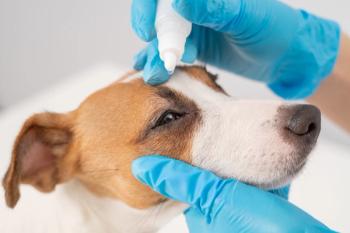
Basic ophthalmic diagnostic techniques for technicians (Proceedings)
History, ocular surface diagnostics, tonometry, culture and sensitivity, cytology, biopsy, ERG, ultrasound
History - things to find out for your doctor:
Signalment (Age, breed, sex, weight)
Indoor/outdoor, travel, other health issues, current medications
How long has the problem been present; one or both eye involvement
Discharge – color, quality, quantity
Is pain present? What is the color of the eye and conjunctiva?
Is there a change in vision; all the time?, in light?, in darkness? What was the time course?
Neuro-ophthalmic diagnostics
Symmetry
Orbit ; enophthalmos, exophthalmos, eye position
Menace: wave briskly at each eye, HOWEVER do NOT create too much air current enabling the patient to feel the "menace" movement; some people do this behind a clear plexiglass shield
Dazzle: a brisk blink or retraction of the globe in response to bright light; this is a subcortical response meaning that a positive response may occur without actual vision; a positive dazzle does not equal vision
Palpebral: blink reflex, controlled by the 7th cranial nerve
Pupillary light reflex: constriction of the pupil in response to light
Vision
Scotopic: vision in low light/darkness, mostly rods are involved
Photopic vision in normal light, fine focus and contrast involved; mostly cones are involved
Maze testing: set up a maze using chairs, waste baskets, etc. and le the patient maneuver through it in different light conditions
Ocular surface diagnostics
Tear film assessment:
Schirmer tear test – leave in the lateral aspect of the eye after placing it in between the cornea and lower eyelid for 60 seconds; handle the strips as little as possible as the oils from your fingers will affect tear uptake
Normal = more than 15mm wetting/minute
Suspect = 10-15mm wetting/minute
"Dry eye" = less than 10 mm wetting/minute
Phenol red thread test – uses pH indicator to measure tear production; the thread is 75mm long and changes color as the slightly alkaline tears are absorbed along the thread; it only has to stay in the conjunctival fornix for 15 seconds; normal values are 34mm/15 sec for the dog and 23mm/15 sec for the cat
Tear film break-up time – the tear film should stay in an even, consistent layer over the cornea for at least 20 seconds; the test is performed by placing a drop of fluroscein on the cornea and then holding the eyelids
open while observing the tear film with a black light or cobalt blue filter; the test evaluates mucin function and production
Corneal integrity
Fluroscein stain – the stain is a weak dibasic acid with an absorption spectrum of 490nm; after sodium fluroscein absorbs light (qpprox. 100% is absorbed) it emits fluorescent light with a peak wavelength of 520nm
Wicking – does the stain overflow the lid margin and flow down the face?; if so there may be an eyelid or hair abnormality
Corneal uptake – indicates an ulcer; stain is absorbed if the corneal epithelium is absent, however Descemet's membrane does not absorb stain so evaluate potential ulcers while keeping that in mind
Nasolacrimal dye test (Jones test) – does stain appear in the patient's nostrils or on the tongue after 5 minutes; if not the tear ducts may be blocked; it is not unusual for brachycephalic (flat-faced) breeds to have negative tests (their tear duct is so convoluted that the stain cannot travel down the duct very easily)
Rose Bengal stain – stains unhealthy epithelium; often used for diagnosing herpes virus in cats
Lissamine green stain – also stains unhealthy epithelial cells; similar to rose bengal
Tonometry
Reason: to check for ocular disease; they pressure should not be too high or too low
Schiotz tonometer
Tonopen
Tonovet
Digital
Culture and sensitivity - try to obtain prior to using topical drops on the cornea
Cytology – obtain by scraping or using a Kimura spatula
Biopsy
ERG – electroretinogram; used to diagnose visual disturbances and abnormalities of the retina
Ultrasound – may aid in diagnosis when the retina and posterior segment cannot be visualized
Use 10-12 MHz probe for the back of the eye
Use 20-30 MHz for the front of the eye
Newsletter
From exam room tips to practice management insights, get trusted veterinary news delivered straight to your inbox—subscribe to dvm360.




